
views
Researching Squirrel Ownership

Make sure you know the relevant laws in your area. Contact your local municipal office for more information about the laws surrounding pet ownership in your area. Owning a pet squirrel is not legal in all municipalities, while a permit might be required in others. It is best to inform yourself before obtaining a pet squirrel to avoid fines and forced surrender of your pet.

Look for veterinarians who will treat a squirrel. Before investing time, money, and a piece of your heart in a squirrel, check with all vets in your area to see if they will treat one. Ask if they are experienced in working with wildlife or exotic animals. Alternatively, contact an experienced wildlife rehabilitator for advice and guidance about how to treat your squirrel in the event of a medical issue.

Make sure you adopt a squirrel at the right age. After about nine weeks of age, squirrels will have difficulty acclimating to strangers. If you are thinking about taking in an abandoned squirrel, be sure that it is young enough to accept and trust you. For an accurate assessment of a squirrel's age, bring it to a veterinarian.

Leave the squirrel in the wild if you can. If you come across a baby squirrel that is on its own and uninjured, leave it alone for at least a few hours to give its mother a chance to find it. Monitor the small squirrel from a safe distance to ensure that it survives during that time. Retrieve the baby squirrel if: It seems sick or injured. Its mother is dead or out of the picture. It faces danger from a family pet.
Feeding Your Squirrel
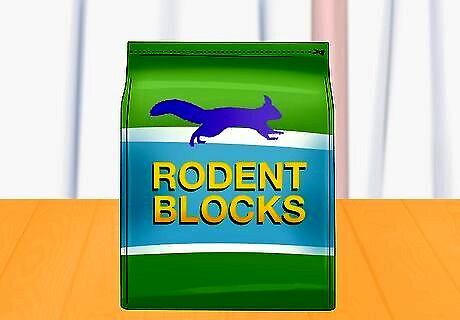
Buy rodent blocks. To ensure your squirrel's complete nutrition, buy rodent blocks at your local pet store or online. The blocks will contain most of the nutritional elements that your squirrel needs and make feeding simple. If your squirrel does not show interest in eating its rodent blocks, try coating them with a very thin layer of peanut butter or rub them with apple or grapes to sweeten them. Feed your squirrel 3-4 blocks a day, and replace uneaten blocks daily to ensure freshness and prevent germs.
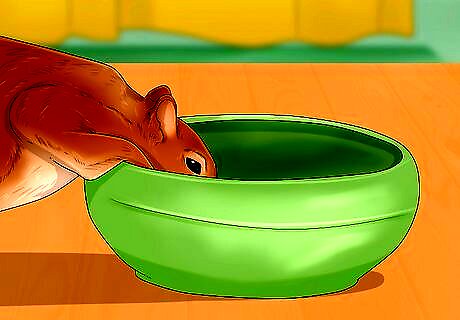
Provide a constant supply of water. Make sure that your squirrel always has access to clean, fresh water. Dehydration can be very dangerous to both young and adult squirrels, particularly in hot summer months. Refill a water dish daily, or more if your squirrel is thirsty.
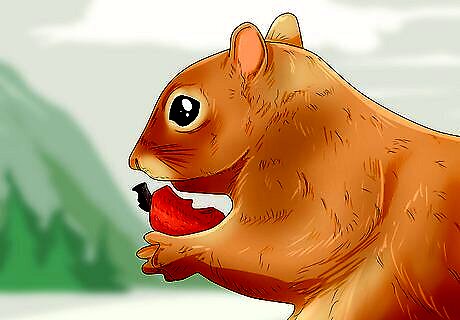
Supplement your squirrel's diet. While rodent blocks should make up at least 80% of your squirrel's diet, you can supplement it with other things. Choose foods that they might eat in nature, such as fruit or insects. Be sure to remove or replace any fresh foods that go uneaten from your squirrel's food dish to prevent the growth of bacteria. Adding additional food sources can boost your squirrel's calcium intake, which is important to maintain strong bones and teeth. Purchase crickets to feed your squirrel from a local pet store. Offer your squirrel a variety of fruits, but in moderation. These might include berries (e.g., blueberries, blackberries, strawberries) and cut-up pieces of larger fruits (e.g., banana, apple, peach, mango.)
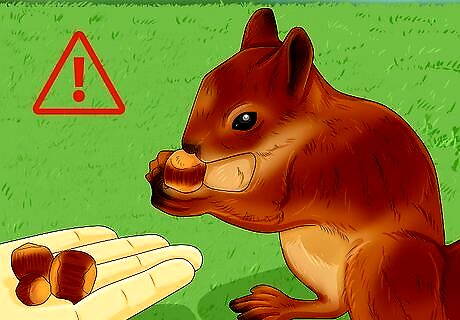
Limit seeds, corn, and nuts. While it is tempting to feed a pet squirrel large quantities of seeds, corn, and nuts, they are not healthy choices and may cause obesity over time. Think of these foods as being like candy for squirrels and serve them in moderation. Opt to give small quantities of these treats to your squirrel at the end of the day, after they have filled up on healthier foods. Over-consumption of seeds, nuts, and corn can also contribute to the risk of nutritional disorders like metabolic bone disease.
Creating the Right Living Environment
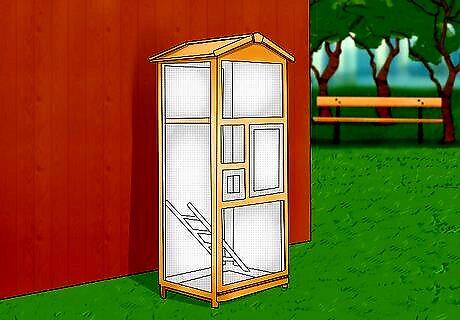
Buy a suitable cage. A pet squirrel will require a cage that is at least two feet wide, two feet deep, and several feet tall (about 0.6 meters wide, 0.6 meters deep, and at least a meter tall.) Squirrels are active animals and need to be able to move around. Provide covered spots for your squirrel to hide in when it wishes to do so. Squirrels have very strong teeth, so opt for a metal cage over wood or plastic. Make sure to buy a secure cage as squirrels are good at getting through small spaces.

Give your squirrel things to climb on. Make sure that your squirrel has things to climb on to mimic its natural environment, such as pieces of wood or clean, sturdy branches. Hanging parrot toys and perches are also suitable choices. Make sure that any hanging toys are securely installed in the cage before allowing your squirrel to crawl on them.
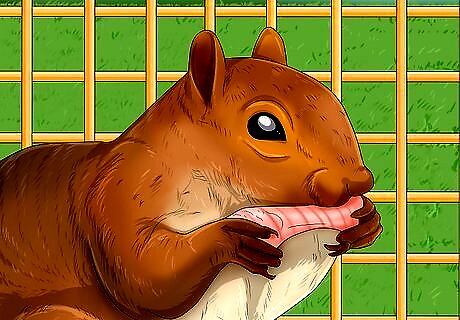
Provide things for your squirrel to chew. Squirrels have strong teeth and a natural tendency to chew things, so provide them with things to chew. Chew bones will allow your squirrel to wear down their incisors without destroying other things, and may provide calcium to their diet. Sturdy chew toys are also a good choice, but should be cleaned every week to prevent the growth of bacteria.
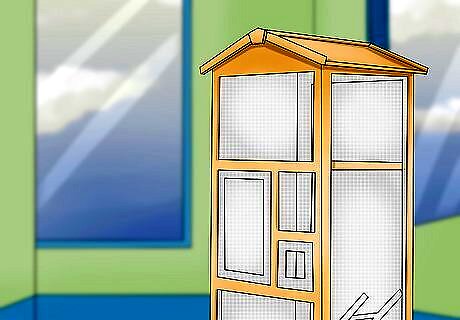
Position the cage near a window. Position your squirrel's cage near a window to give it access to sunlight. Proximity to the outdoors will mimic its natural living environment. Open the window whenever possible so that your squirrel can experience the sounds and smells of the outdoors.
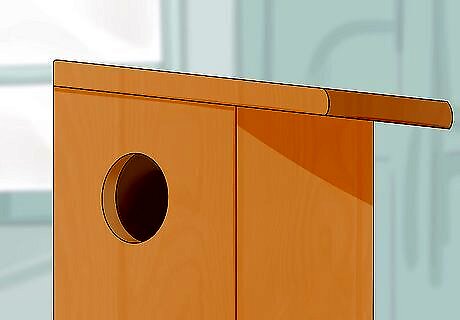
Give your squirrel a nest box. Squirrels like to have a secure and cozy place to sleep. Place a small cardboard box in the cage with a hole in it large enough for your squirrel to crawl in and out. You can also purchase a wooden nesting box for your squirrel at a pet store or online. Be sure that the nesting box you purchase has a hole large enough for your squirrel to get through.
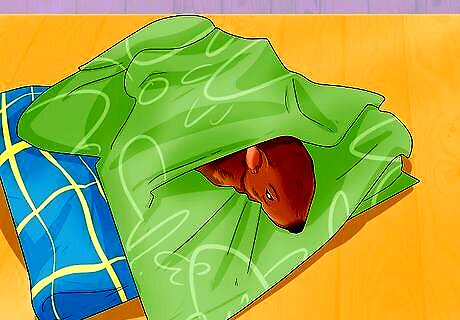
Provide bedding material for your squirrel. Make your squirrel's nesting box more comfortable by placing soft materials in it. Avoid using an old towel or terrycloth, as your squirrel's nails can get caught in the fabric loops. An old t-shirt, fleece blanket, or shredded newspaper are all good options. Replace the shredded newspaper or wash the t-shirt or blanket once a week. Remove and replace fabric from the nesting box if your squirrel chews it.
Keeping the Squirrel Safe and Healthy

Keep other pets away from the squirrel. To keep your pet squirrel safe, keep dogs and cats away from it. It is difficult to predict a squirrel's behaviour and even the most well-trained pet may cause it harm in self-defense. Squirrels are prone to biting and may also harm your other pets is cornered, threatened, or playing roughly.

Socialize your squirrel. Handle your squirrel from a young age so that it gets accustomed to human contact. Avoid too much physical contact once the squirrel is about six months old, however, as its teeth and nails will grow in sharper. A happy squirrel may inadvertently cause harm to you or your family members.
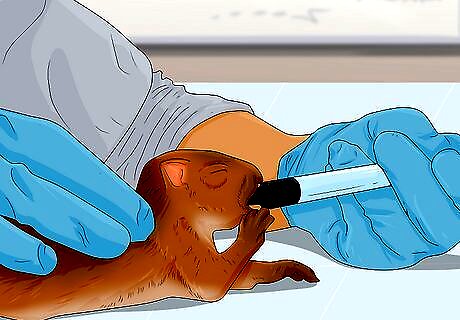
Take the squirrel to the vet for regular checkups. Bring your squirrel for yearly check-ups at a veterinarian experienced in squirrel care. The veterinarian's directions for diet, care, and treatment should be followed closely. You should also bring your squirrel to a veterinarian immediately if it exhibits signs of illness.



















Comments
0 comment